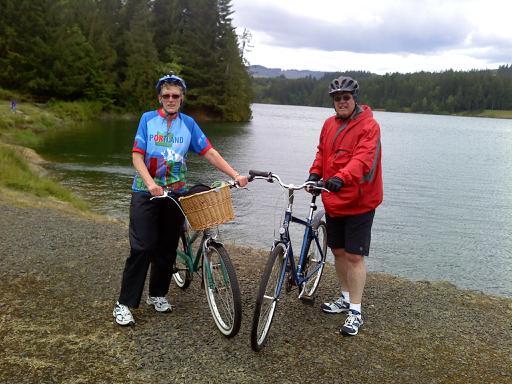






We're on Texel, one of the Netherlands' barrier islands to the north of the country. Starting from the bottom of the photos, Texel is a fishing town. This is a photo of only a few of the town's fishing boats tied up for a Sundeay rest. In fact, so many fishing boats were tied up that we had to moor alongside one and cross their deck before leaping across a small void onto the dock. Coincidentally the ship to which we are tied flies a Jolly Roger (pirate) flag. Don't see any pirates, though.
The next photo above is of a row of fisherman's houses, small and very quaint. They face the shore side of the island, where they are protected from North Sea storms and are also protected by a very tall dike on the leeward side of the island. The third photo shows a row of wooden shoes lined up on the doorstop of one of the fishing cottages.
Above that are two photos of the "hippie bus" we passed while biking. There are a lot of artists on the island, who have small stands outside their homes, selling homemade crafts.
Above that is a photo of the Georgian (Russian) cemetery on the island. there were around 800 Georgian soldiers taken captive early on in WWII during the blitzkrieg and brought to Texel as German prisoners of war. Of these 800, around 500 survived the trip to Texel. During the war, as Texel was somewhat removed from the brunt of the fighting and since the prisoners were on an island, they had a somewhat "normal" life. Some of them fell in love with local girls and even fathered children. As the war wound down they began to worry, since Stalin considered Russian POWs to be traitors and the Georgian soldiers were afraid of being imprisoned when repatriated to Russia. They saw that Southern Netherlands was being liberated. They decided to revolt against their German captives. The Germans, on the other hand, although they knew their country was being defeated, decided to go out in a blaze of glory by fighting against the Georgians, and a very bloody battle resulted. Over 400 Georgians, many local folks and a couple of hundred Germans were killed. Two weeks later the Netherlands was liberated. Of the 800 original prisoners only 200 remained alive. Those who died are commemorated in this park, with each rose representing a dead Georgian.
Now about the sheep (last photo). The fence around the sheep is made of branches and weeds tied together and placed in rows, surrounded by mud. This provides a more beautiful background for people to see and also provides a home for mice and other creatures of the field. This type of fencing is being erected more and more in the Netherlands. What were told about the sheep is this: If a sheep falls down onto its back (not its side), it is unable to get back up and will eventually die within about 2 hours' time. So we were told that if we saw a sheep lying on its back, we should immediately run out into the field and turn it onto its side, sort of a sheep resuscitation move. (No mouth-to-mouth involved -- tee hee) But one must turn the sheep back into the direction from which it fell, as if you turn it the other way, the internal organs will become twisted and the sheep will die. In fact, the first full day of biking we came across a dead sheep, presumably one who had fallen and couldn't get back up in time.
So now you know all we know about sheep tipping.
We sail back to the mainland around 4:30 today to catch the tides. The inland sea on the leeward side of the island is tidal and we must catch the high tide. More tomorrow.

No comments:
Post a Comment